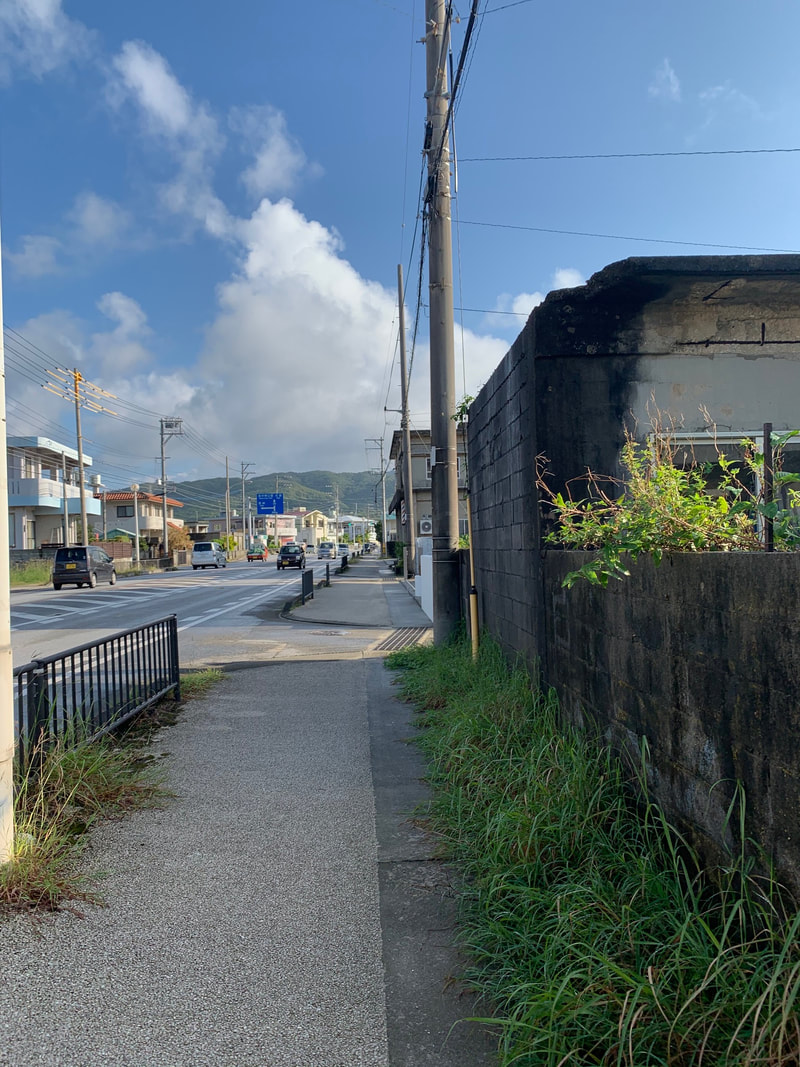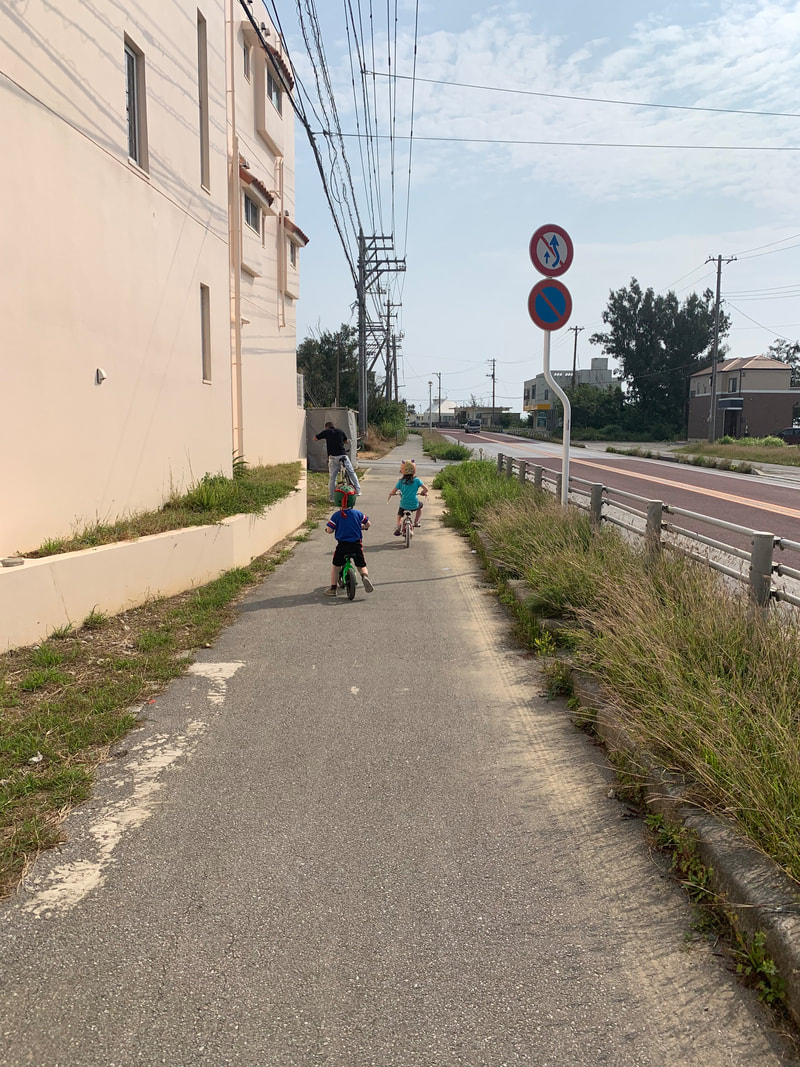 Pre COVID-19, Stroller Warriors of Okinawa on a long run along Ayahashi bridge.
Pre COVID-19, Stroller Warriors of Okinawa on a long run along Ayahashi bridge. I love watching the locals and learning from them, it’s amazing what you can learn when you pay attention! I talked with Stroller Warriors from Iwakuni and Zama to compare and contrast experiences. So here we have for you, our lessons learned about running in Japan.
Attire: It’s HOT in Okinawa with high temperatures and 100% humidity. You’d think all runners would be wearing as little clothing as possible. That’s not so in Japan! Japan is a very modest culture and community and taking your shirt off to run is unheard of (unless you’re an American who doesn’t know any better). Even in high heat with high humidity you will see Japanese locals running or walking in long pants and long sleeves. At a minimum they will have shorts and t-shirts on. Usually they won’t even have sweat stains on their clothes. How so, you ask? A Japanese friend once told me they have the same concept as maxi pads but to stick to the underarms of your shirts to collect the sweat. Stroller Warriors who have lived on mainland Japan report the Japanese dress modestly while exercising there as well.
Safety: Japan is a lot safer than the US. I have never been cat called at or followed while running in Japan and neither have Mallory, Colleen and Katie who were stationed in mainland, Japan. Whether you’re in Okinawa or on mainland, Japan, chances are you will feel a lot safer while running solo. If I run early in the morning or late at night I’m not nervous about getting attacked by a human (though I am still on alert!). Instead, my mind is worried about habu snakes (that are nocturnal and incredibly territorial in addition to being one of the most venomous snakes). I still prefer to run in the company of others, but I love feeling safe in the community I run in!
 The sidewalks are nice and big.
The sidewalks are nice and big. In mainland, Japan the sidewalks aren’t so ample and large. Colleen says, “On base the sidewalks would accommodate one double, maybe two singles. Off base sidewalks are more non existent. Every once in a while you might find a bicycle path that cuts through neighborhoods, but they would usually have a barrier pillar at roadway intersections which are difficult to maneuver around. The only place off post I ever took my double was Disney Tokyo and I got SO MANY strange looks I felt like I was pushing a UFO or something.”
Do not always trust that there will be sidewalks! Pretty much all of the old neighborhoods do not have sidewalks. If you run the old neighborhoods, your only choice will be to run in the road which can be very dangerous given the blind corners and fast drivers and mo-ped riders. If you want to try running a new route, I’d recommend driving it first to ensure that it will be stroller and runner friendly.
Which side of the street do you run on? In Japan, the cars drive on the left side of the road (where as in the US they drive on the right side). So if you need to run in the road you should follow safety protocol and run towards traffic, which in Japan means you run on the right side of the road. However, this doesn’t necessarily translate if you run on the sidewalk. When you run on the sidewalk you can run on either side.
In the summer months in Okinawa, there is something you need to do. You need to study both sides of the street to determine which side has more shade! In the summer you will want to run on the shadier side of the street. I swear it is 20 degrees cooler in the shade and it is so nice to be out of the intense, hot sun. We’re closer to the equator here so the sun’s rays are stronger and more damaging. Pick the shade when you can and you’ll be a whole lot happier on your run. In the winter if it’s cold you’ll want to do the opposite and go for the sunny side rather than the shade.
 In the summer you'll be a lot happier on the shadier side of the street.
In the summer you'll be a lot happier on the shadier side of the street. Be very careful when crossing the street. Cars drive on the left side of the road here. So remember how you learned how to look both ways before crossing the street? Well now, you have to start with the opposite way first! You need to look right, left and then right again. You’ll get used to it after a while, and when you move back Stateside, you’ll have to get used to it all over again!
Cross the road, closer to the road, not closer to the building. This is a tip I learned from watching the locals. If you cross closer to the building you are moving from a blind spot right out into the danger zone in the blink of an eye. To make themselves more visible they go out away from the building, towards the street before crossing.
Japanese runners have a tradition of turning after crossing the finish line and bowing to the course. From my understanding, they do not always do this, they only bow to the course when it has been a formidable opponent. On a tough race, like the Shouhashi half marathon in Nanjo, Okinawa you will see whole crowds of people turning to bow to the course. This is good to know so you can slow down and give the people in front of you space after you cross a finish line. They might be stopping and turning when you weren’t expecting it.
The price of racing is much more reasonable here than in the US. In the US I was paying $180-$220 or so for a full marathon. Here, the price to run a marathon is around $40-$60. It seems that in Japan, the larger the race, the more you can expect to pay to be in it.
Japan has a rich culture of running and racing and I am so glad I have been able to be a part of it. From glass medals to clay medals, from locals lining the roads during a race to offer trays of salt or brown sugar, to stopping mid race to take a photo with a bull. I’ve gathered up a million memories and experiences I will treasure forever.
Don’t be afraid to experience something new here in Japan, lace up your shoes and go!
Happy Running!
Kelly





 RSS Feed
RSS Feed